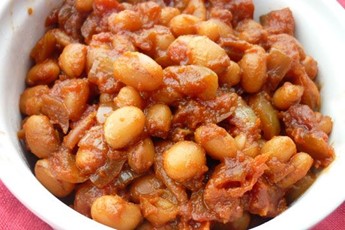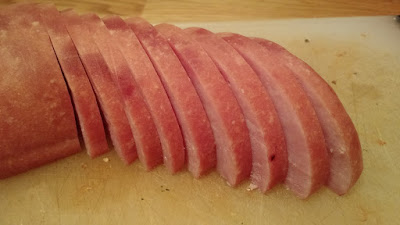Wednesday, October 26, 2016
Chili R&D - Part 2 (Beans!)
If you missed the "Chili R&D" post from last month, it's a pre-requisite for this class.
LINK to Part 1
Feedback from Round 1:
- Beans are successful... but not the navy beans. The flavors didn't merge well.
- Veggies are best appreciated when chopped, not powdered.
- Gravy was slightly too thick and greasy. Less corn starch and fat are required.
Variables:
- Bean type (black vs pinto vs red kidney)
- Veggie size (diced vs powdered)
- Gravy viscosity (corn starch and fat content)
Controls:
- Spice mixture
- Meat type and quantity
- Sauce recipe
Begin by arranging your ingredients.
And your spices.
Brown 3 lbs ground beef.
Skim some fat from pan until the bottom has a thin film.
Form the ring of flavor.
Cook down 2 onions.
Until they are translucent.
Add beans (1 can of each), 2 finely diced jalapenos, 4 cloves garlic, and 4 tomatoes.
Add the V8, beef broth, tomato sauce, and spice mixture (LINK to Part 1 without the garlic powder and onion powder).
Stir and let simmer for 2 hours. In the final 15 minutes, temper in corn starch to the desired thickness (it will stiffen as it cools).
Serve alone or with rice... or like we did with potato skins and cornbread muffins. Garnish with cheese, sour cream, green onions, and your favorite topping.
Wednesday, October 19, 2016
Cuban Sandwich
A quality sandwich isn't just a neat package for nutrition, it's a 1-2 punch of flavor and texture. Salty, sour, savory, creamy. Melty, chewy, fluffy, crispy. These are good descriptors of the Cuban sandwich... a simple recipe that transforms into a deli delicacy if you extract all the flavor from each ingredient.
Ingredients:
- Ham with natural juices (not pre-sliced)
- salami (thin sliced)
- swiss cheese (sliced)
- dill pickles (sliced)
- yellow mustard
- thin, crusty bread (like a baguette or similar roll)
If you watch enough Good Eats, you'll know what "Ham with Natural Juices" means. Slice into 1/4" slabs.
Test your elementary school shape skills, to maximize coverage and minimize waste.
Organize your ham optimally and lightly season with your favorite spice blend.
Pan fry the ham until both sides are browned.
For bonus points, add salami for a contrasting meaty texture.
Also pan fried to perfection.
Organize the ingredients for assembly. Start with mustard on both sides.
First layer is the ham.
Second layer is the salami.
Third layer is the swiss cheese.
And finally, pickles.
Assemble your sandwiches and fire up the griddle!
On an angle, grill the sandwiches.
With the panini hinge released, press down on the sandwiches and re-align/-assemble sandwiches as needed.
Slice the sandwiches onto triangles for maximum drool factor.
Serve with chips or fried plantains
Wednesday, October 12, 2016
Boston Baked Beans

Shameful Omission: We forgot to take a final picture. Here's a picture that looks really similar from lovefood.com.

If you recall our New Year's recipe of Black-Eyed Peas (LINK), this will be pretty similar. It's a slow-cooking dish with simple ingredients that meld into magic. The Boston Baked variety highlights the classic American flavors of molasses, ketchup, and brown sugar.
Here's the recipe:
1 pound Navy beans or kidney beans
1/3 cup molasses
1/3 cup brown sugar
1/4 cup ketchup
1/2 pound salt pork
2 onions
4-6 cloves of garlic
1/2 teaspoon of ground mustard
1 tablespoon of cumin
1 tablespoon of paprika
2 teaspoons of salt
2 teaspoons of black pepper
a few dashes of Worcestershire sauce
Soak the beans overnight in a gigantic bowl.
Start by browning the outside of the salt pork.
I added some cumin for flavor (optional).
Chop the garlic and slice the onions.
Pull the browned salt pork, and start cooking down the onions in the pork drippings.
Chop the salt pork into 3/8" x 3/8"
Add the garlic and salt pork when the onions start to soften.
Add all of the remaining ingredients (ketchup, molasses, brown sugar, Worcestershire, seasonings).
Drain the beans and add them.
Fill with water to cover the beans and mix thoroughly.
Bring to a boil and simmer until the beans are tender and the sauce has thickened. You're allowed to over-cook these, compared to black-eyed peas and red beans. It should take a couple hours.
The final product should be soft, syrupy, and flavorful. (shame! borrowed picture)

Wednesday, October 5, 2016
Creole Jambalaya
An important distinction to make is Creole vs Cajun. Cajun comes from the term "Acadiana" which describes the central and southern Louisiana areas and its culture. Creole refers to the people and culture that blended the French colonial culture with African, Caribbean, and native people.
Cajun cuisine uses a limited set of ingredients, which were easily accessible to the area. Ingredients often traveled along the Missisippi river and local roads. It's generally considered "country food."
Creole cuisine has access to a wider pantry, due to the trading through the port of New Orleans. The people brought a "big city" spin on the classic Cajun dishes. Since this jambalaya uses tomatoes, it's considered Creole (although my family grew tomatoes in Bossier City, LA).
This recipe will be very familiar to those who are playing along at home (LINK to Gumbo). Instead of being a soup, it's a rice-based dish with similar preparation and ingredients. The recipe comes from the Junior League of Lake Charles and their book "Pirate's Pantry."

We begin by chopping the mirepoix (celery, onion, and bell pepper) with a couple cloves of garlic.
Slice the sausage and allow the shrimp to thaw.
Start the roux with canola oil and flour.
Once the roux is "blonde" drop in the sausage.
After a couple minutes of browning, drop in the bell pepper (since it takes longer to cook).
After a couple minutes, drop in the onion and celery.
After a couple minutes, drop in the garlic and keep stirring to prevent burned garlic.
If you're using the Creole recipe, add diced tomatoes and some water to "soupy" consistency.
Add your favorite spice blend. Generally, jambalaya is not prepared as spicy as gumbo, but the world is your spice cabinet.
Let the sausage and veggie mixture stew. Add the spice blend, then peel the shrimp.
Drop in the shrimp and rice.
Bring to a boil and allow to simmer until the rice has absorbed all of the liquid.
The final product should look like this:
Remove the bay leaves and serve with some green onions on top.
Subscribe to:
Posts (Atom)

























































